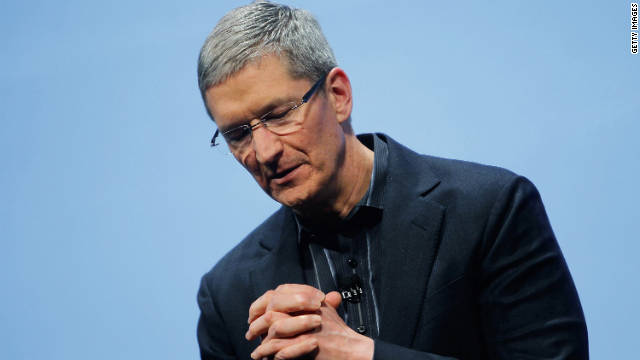 |
| Apple's Tim Cook speaks during the iPhone announcement in January in New York. |
STORY HIGHLIGHTS
- Maintaining Apple's rapid growth will be a big challenge for new CEO Tim Cook
- Cook must keep driving product development and Apple's logistics revolution
- Apple could end up shipping more than 175 million gadgets this year
- Cook is expected to unveil a new iPhone Tuesday in California
(CNN) -- On Tuesday, new Apple CEO Tim Cook is expected to help unveil Apple's latest iPhone at its first big event since co-founder Steve Jobs stepped aside in August.
Cook will no doubt be scrutinized for how he fulfills his new role Tuesday as chief pitchman for Apple's products. And the new iPhone, expected to go on sale sometime in mid-October, will almost certainly draw lines of shoppers outside Apple's stores.
Then the question becomes: Can Apple make enough iPhones fast enough? As demand for its gadgets continues to skyrocket, keeping Apple growing at its amazing pace will be a key hurdle for Cook's regime.
The consumer shift toward cheaper, portable computers -- and Apple's huge success there with the iPhone and iPad -- means creating and selling an ever-increasing number of devices each year. Right now, for example, Apple will have to ramp up production of millions of new iPhones, and possibly new iPods, for the holidays. After that there will be more iPads, Macs, and other products.
It's important that Apple's new devices be stylish and technically impressive. But it's equally important that they be in stock when people want to buy them, something that Apple hasn't always been able to deliver. Only recently, for example, has the iPad 2 supply been able to meet demand. And as time goes on, thanks in part to new markets such as China, demand for each gadget will only grow.
It's not enough for Cook and his team to keep coming up with exciting new products. They also must continue Apple's logistics revolution, so that consumers don't have to wait forever to buy new Apple devices -- or turn instead to the competition.
Consider the total number of devices Apple must now have built and shipped per year. In 2011, including all iPhones, iPods, iPads, and Macs, Apple could end up shipping more than 175 million gadgets -- some 50 million more than it did last year, representing roughly 40% growth.
Next year, Apple is expected to ship an all-time high of around 215 million devices, or another 40 million more than this year. And so on.
It wouldn't be insane for Apple to have to ship 500 million units per year by the end of the decade. So Cook will have to figure out how to become the type of company that can ship 500 million gadgets per year -- from staffing to product design to iCloud server infrastructure to components to manufacturing, sales and support.
The good news: Cook is already, arguably, the best in the business when it comes to this stuff. Over the past decade, he's made Apple's supply chain an industry leader. For Cook and Apple's SVP of Operations Jeff Williams, the plan is to keep it that way. (See Fortune Magazine's recent profile of Williams here.)
As Apple enters its next chapter, some of Cook's biggest practical challenges will include scaling production, deciding how to prioritize the company's existing businesses and figuring out which new businesses to enter -- such as making TVs. (Then there's the whole "vision thing," which is a whole different challenge -- and where Jobs, the master innovator, may prove to be irreplaceable.)
Later this month, Cook will make his first pitch to Wall Street as Apple's CEO, as Apple reports its quarterly results. A year from now, we'll be in good position to judge his performance at the helm of the world's most valuable tech company.
But first, it's time for a new iPhone.




{ 0 comments... Views All / Send Comment! }
Posting Komentar